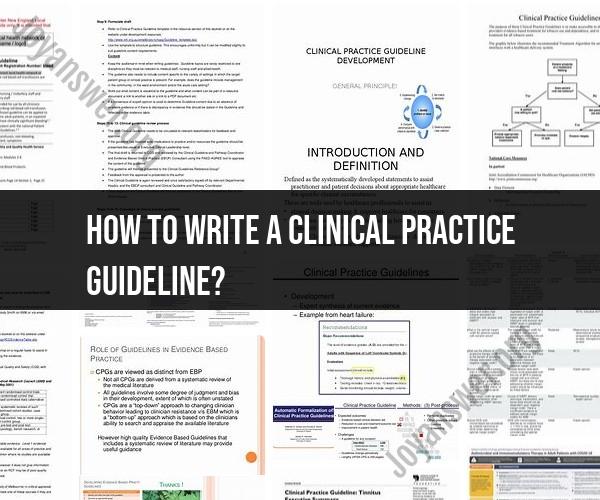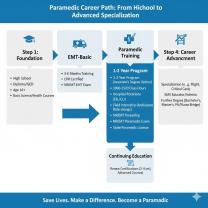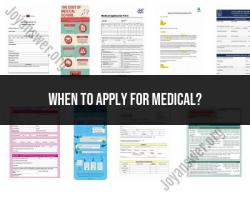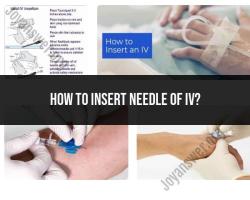How to write a clinical practice guideline?
Writing a clinical practice guideline (CPG) is a complex and meticulous process that involves multiple steps, collaboration among experts, and adherence to rigorous standards. CPGs are important tools in healthcare to guide clinicians in making evidence-based decisions for patient care. Here's a comprehensive guide on how to write a clinical practice guideline:
1. Define the Scope and Purpose:
- Determine the specific clinical topic or question that the guideline will address.
- Clearly define the scope, objectives, and goals of the guideline.
- Identify the target audience (e.g., physicians, nurses, policymakers) and the setting in which the guideline will be applied.
2. Assemble a Guideline Development Group:
- Form a multidisciplinary team of experts, including clinicians, researchers, methodologists, and relevant stakeholders.
- Ensure that the panel members have no conflicts of interest that could bias the guideline's development.
3. Conduct a Systematic Review:
- Conduct a comprehensive systematic review of the available evidence related to the clinical question or topic.
- Follow established guidelines for conducting systematic reviews and meta-analyses.
4. Grade the Evidence:
- Assess the quality of the evidence using standardized grading systems (e.g., GRADE, AGREE).
- Assign levels of evidence and strength of recommendations based on the quality of the evidence.
5. Formulate Recommendations:
- Develop clear and concise recommendations based on the available evidence.
- Consider the balance between benefits and harms, patient values and preferences, and resource implications.
- Clearly state the strength of each recommendation (e.g., strong, weak) and the level of evidence supporting it.
6. Write the Guideline Document:
- Organize the guideline into sections, including an introduction, methods, recommendations, and supporting evidence.
- Use clear and unambiguous language, and avoid jargon.
- Include tables, figures, and algorithms to enhance clarity.
- Provide references to support statements and recommendations.
7. External Review and Feedback:
- Seek external peer review of the draft guideline from experts who were not involved in its development.
- Consider feedback and make necessary revisions to improve the guideline's quality.
8. Finalize and Publish:
- Finalize the guideline document based on feedback and internal consensus.
- Publish the guideline through reputable healthcare organizations or journals.
- Make the guideline freely accessible to the intended audience.
9. Implementation and Dissemination:
- Develop strategies for disseminating and implementing the guideline in clinical practice.
- Consider the use of educational materials, workshops, and electronic health record integration.
10. Regularly Update:- Guidelines should be reviewed and updated periodically to incorporate new evidence and ensure their continued relevance.
11. Monitoring and Evaluation:- Establish mechanisms for monitoring guideline adherence and evaluating the impact on patient outcomes.
12. Transparency and Documentation:- Maintain transparent documentation of the guideline development process, including potential conflicts of interest, methods used, and decisions made.
Writing a clinical practice guideline is a collaborative effort that requires rigorous methodology, transparency, and continuous updating to reflect advances in medical knowledge and changes in clinical practice. It's essential to involve experts, follow established guidelines for guideline development, and ensure that the guideline is evidence-based and clinically relevant.
Crafting Effective Guidance: A Step-by-Step Guide on Writing Clinical Practice Guidelines
Clinical practice guidelines (CPGs) are documents that provide evidence-based recommendations on how to diagnose, treat, and prevent diseases and conditions. They are developed by multidisciplinary teams of experts and are intended to help healthcare providers make the best decisions for their patients.
Here is a step-by-step guide on writing clinical practice guidelines:
- Identify the need for a CPG. What are the most important clinical questions that need to be addressed? What is the current state of the evidence on these questions?
- Form a multidisciplinary team. The team should include experts in the relevant field, as well as consumers and other stakeholders.
- Scope the CPG. Define the topic of the CPG, the target audience, and the intended use of the CPG.
- Conduct a systematic review of the evidence. Identify all relevant studies and assess the quality of the evidence.
- Develop recommendations. The recommendations should be based on the evidence and should be clear, concise, and actionable.
- Review and revise the CPG. The CPG should be reviewed by experts and stakeholders to ensure that it is accurate, comprehensive, and balanced.
- Disseminate and implement the CPG. The CPG should be disseminated to healthcare providers and other stakeholders. It should also be implemented in clinical practice.
From Research to Practice: How to Create Clinically Sound Guidelines
To create clinically sound CPGs, it is important to follow a rigorous development process that is based on the best available evidence. The following principles are essential for developing clinically sound CPGs:
- Transparency: The development process should be transparent and open to public scrutiny.
- Evidence-based: The recommendations should be based on the best available evidence.
- Multidisciplinary: The CPG should be developed by a multidisciplinary team of experts.
- Stakeholder involvement: Consumers and other stakeholders should be involved in the development process.
- Implementability: The CPG should be feasible to implement in clinical practice.
- Up-to-dateness: The CPG should be reviewed and updated regularly.
Communicating Medical Best Practices: Writing Clear Clinical Guidelines
CPGs should be written in a clear and concise style that is easy for healthcare providers to understand. The following tips can help you to write clear CPGs:
- Use simple language and avoid jargon.
- Define any technical terms that you do use.
- Use clear and concise sentences.
- Organize the CPG in a logical way.
- Use headings and subheadings to break up the text.
- Use tables and figures to summarize complex information.
- Provide examples and case studies to illustrate your points.
- Review the CPG with a non-expert audience to make sure that it is easy to understand.
By following these tips, you can write clinical practice guidelines that are effective, clinically sound, and easy to understand.












